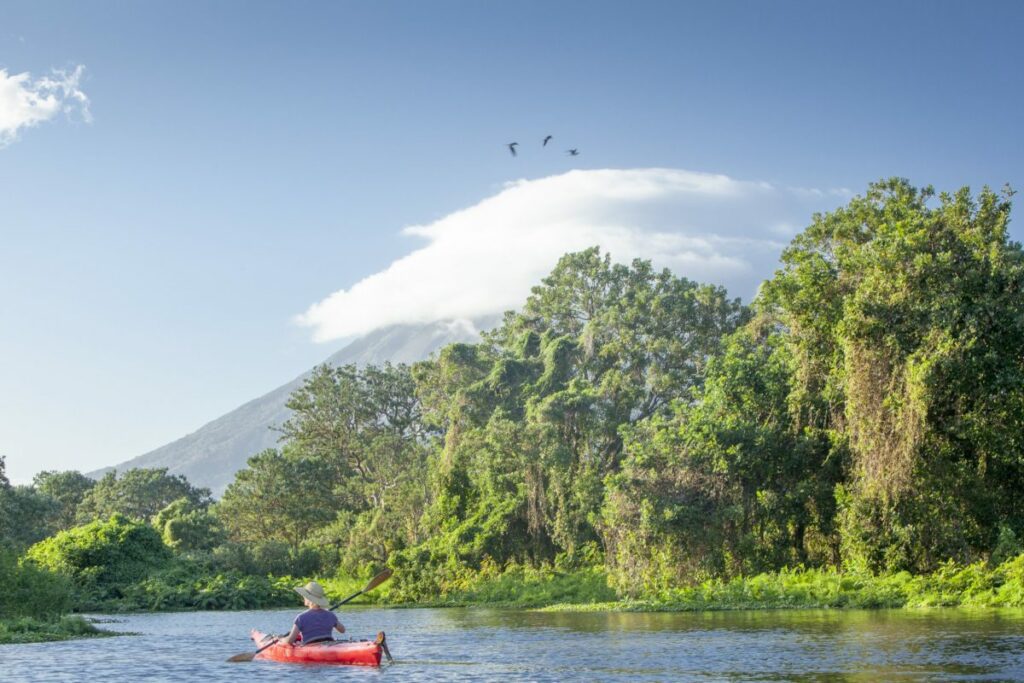In Nicaragua, “the land of lakes and volcanoes”, I’m climbing steeply, heaving and sweating. My legs are on fire; my heart is pounding. Finally, the ascent is complete. It feels like I’ve just scaled one of the 19 active volcanic peaks that embroider this neighbour of Costa Rica – but I’ve merely made it to the rooftop of Leon’s brilliant white cathedral.
It’s here I peer across the higgledy-piggledy cityscape of Nicaragua’s second city, surveying the terracotta-tile roofed buildings in front of a bottle-green band of trees. Behind this lies a majestic chain of volcanoes – where the real adventure awaits.
Read Next
The threat of civil unrest remains across the country’s towns and cities after a failed coup in 2018 – anti-government protests in recent years have resulted in an increase in arbitrary detentions. However, the Foreign Office relaxed its travel advice to the country in 2019.
Now, it simply advises to stay away from demonstrations, and that protests can cause travel disruptions. Meanwhile, the country is seeing an uptick in nature-based tourism, with visitor numbers increasing and many coming to enjoy the country’s fertile landscapes and adventure.
The Maribios Volcanic Chain line-up, which I peer at from Leon Cathedral, begins with the mighty San Cristóbal – at 1,745 m, Nicaragua’s tallest peak; then Casita, feared since a 1998 landslide that killed 2,500 people. “Then you can see Telica, expelling gas. But that’s normal,” says the cathedral’s student guide Carlos, wholly unconcerned by the black plume.
Further on is Momotombo, which has become the national symbol. In 1902, when the US was deciding where in Central America to build an inter-oceanic canal, lobbyists from neighbouring Panama sent Congress a Nicaraguan stamp. The image of a smoking Momotombo was enough to convince them to decide on the Panama Canal.
However, controversial plans to build a canal in Nicaragua have been dragging on for more than 150 years, with the most recent proposed construction officially halting earlier this year.
In ancient times, these behemoths were the subject of reverence and lore. But today, improvements in volcanic forecasting means these peaks are now an adventurer’s playground with their huge craters, sharp-rimmed lakes and steep inclines.
If the first stop for outdoor adventure in Central America’s largest country isn’t surfing in the Pacific Rivas province (with all the surf breaks of Costa Rica, for a fraction of the price for accommodation and tuition), the volcano of Cerro Negro certainly will be. Situated in the middle of the chain, it’s the youngest of Central America’s volcanoes, and suitably feisty: it has erupted 20 times in its 150 years, the last time in 1999.
Unusually, ash from these eruptions drifted gently like fine black snow to blanket its slopes. Now it’s the home of Nicaragua’s wildest sport: volcano boarding.
Combining the thrill of snowboarding with the jeopardy of an active volcano that’s overdue an eruption, its participants climb the volcano then descend on a board at speeds of up to 40km an hour. Nearby, it’s possible to swim Volcan Asososca’s crater lake and camp in a sinkhole on Volcan El Hoyo.
But I’m a hiking girl, which is why at Volcan Mombacho, on the outskirts of the pastel-painted colonial city of Granada, I forgo ziplining in its cloud forests or visiting its coffee plantations to trek the crater.
It’s quite the drive to get there. First, an easy half hour from Granada, then a 4×4, whose growling engine fights to haul it up 6km of rollercoaster-steep angles to the starting point of the trek.
Here, in thick, unruly cloud forest, each tree is visibly its own ecosystem: vines are draped over branches, which form an anchor point for spiders nesting in the trunks, which are eaten by birds hiding in the canopy. On the ground, bromeliads hold onto water droplets, keeping the forest fertile.
Eventually, the path opens to a stunning, silent plateau overlooking Granada and Lake Nicaragua, the region’s largest lake. The plateau is filled with plants and orchids endemic to the volcano. There’s birdsong all around, and a faint, faraway motorcycle-esque growl of howler monkeys. My shoulders drop. It’s bliss, exactly what I came here for. And there’s no possibility of mistaking where I am – the odd fumarole (tiny openings in the ground that spew sulphuric steam) reminds me I’m on a volcano, acting as a gentle warning that the ground is still alive.
My legs are given a rest on a boat ride on the colossal Lake Nicaragua. It’s twice the size of Essex, with 365 islands. One of the most visited is the backpacker’s hangout of Ometepe, home to 35,000 inhabitants, even more tourists, and two giant volcanoes: Concepción and Maderas.
From the water – which stretches so far you feel as if you’re out to sea – I appreciate Nicaragua’s natural abundance, from regal herons surveying the waters to a family of bold spider monkeys keen to grab food from passing boats.
I also get to indulge my curiosity, ogling at the magnificent architecture of the one-property islands owned by Nicaragua’s entrepreneurs and politicians, which range from modest rustic structures to manicured gardens snaking up to extravagant villas.
Weeks after my visit, Concepción Volcano erupts, throwing up a mass of grey and black plumes that later cover parts of Ometepe Island. The message is received: we might be confident enough to hang out on the foothills of volcanoes, circumvent its craters, or sled down its sides, but we’ll always be at the mercy of Mother Nature.
Getting there
Connecting flights to Managua are available via the US on carriers such as United Airlines and British Airways/American Airlines.
Staying there
Hotel La Gran Francia in Granada has doubles from $92 (£69), lagranfrancia.com.
Selva Negra Hotel in Matagalpa, has doubles from $76 (£57), selvanegra.com/en.
More information
visitanicaragua.com
visitcentroamerica.com
Source link : http://www.bing.com/news/apiclick.aspx?ref=FexRss&aid=&tid=6715e22ead9f44b7bdfc30478e215cef&url=https%3A%2F%2Finews.co.uk%2Finews-lifestyle%2Ftravel%2Fcosta-rica-quiet-affordable-neighbour-surf-volcanoes-3332547%3Fico%3Dmost_popular&c=6394904586294208878&mkt=en-us
Author :
Publish date : 2024-10-20 18:08:00
Copyright for syndicated content belongs to the linked Source.
